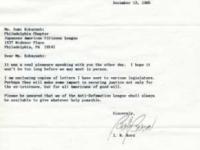On August 10, 1988, President Ronald Reagan signed the Civil Liberties Act of 1988 (also known as Public Law 100-383) into law. This law acknowledged the fundamental injustice of the evacuation, relocation, and internment of United States citizens and permanent residents of Japanese ancestry during World War II. On behalf of the American people, the Act apologized for the grave violation of the constitutional right of due process; made restitution of $20,000 to each surviving former internee; provided a public educational fund to inform the public about the internment; and discouraged such violations of civil liberties in the future. The half-century long journey from internment to reparations represents a case study in both the violation of civil liberties by the federal government and the right to petition that government for a redress of grievances.
This unit pays tribute to a long-time Pennsylvania resident Ms. Sumiko Kobayashi who played a significant role in the movement for redress bill in the Philadelphia region. Kobayashi was born in West Palm Beach, Florida. In 1939, her family moved to San Leandro, California where she graduated from San Leandro High School two years later. In the subsequent year, the family was evacuated to Topaz, Utah. She left the camp in 1943 to attend college in Madison, New Jersey. After the family’s release, they settled in the Philadelphia area in 1947. Kobayashi has been an active member of the Philadelphia Chapter of Japanese American Citizens League (JACL) since 1968. She made a significant difference in the local redress movement through her committed social, political, and cultural activism not only within her own Japanese-American community, but through her connections with a variety of organizations in the region. The decades-long, numerous personal correspondence, meeting minutes, speech notes, budget plans, and newspaper clippings in her papers are a living testament to a determined spirit to work for the good and just of one’s kin as well as one’s neighbors. Although the Civil Liberties Act of 1988 brought legislative closure for the insult and injury, for many Japanese Americans the personal anguish and painful memories remain.


